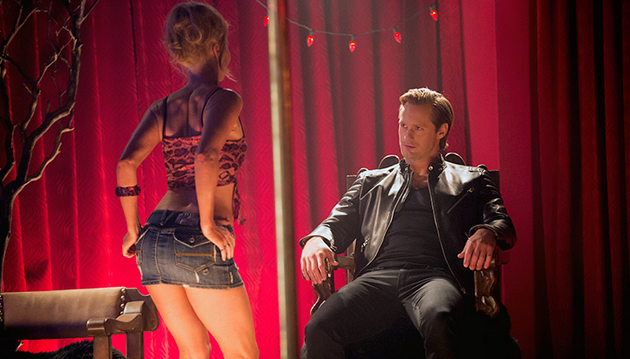How Successful Was 'True Blood' For HBO? A Look Back At Ratings Before Series Finale

In 2008 and 2009, a strange phenomenon bit American pop culture when vampires, formerly just another horror sub-genre, suddenly seemed to be everywhere. The “Twilight” film franchise is largely credited with spearheading the craze, and HBO, always eager to stay on the cutting edge, soon followed with a racy take on vampires for an adult audience – “True Blood.”
Then a funny thing happened. “True Blood” emerged from the trendy vampire pack to become a multi-season ratings juggernaut and one of HBO’s most unlikely flagship programs, spanning seven seasons, which come to an end on Sunday.
“Twilight” was released in November 2008 to big box office and bigger hype. The young-adult vampire love saga, based on a wildly popular series of novels by Stephenie Meyer, unleashed vampire-mania on America. A series of sequels was immediately in the works, studios churned out more and more vampire movies (“Cirque Du Freak: The Vampire’s Assistant,” “Vampires Suck”), publishers got in the game (“Pride and Prejudice and Zombies,” “Abraham Lincoln: Vampire Hunter”), the CW released its own teen TV-series in the genre in 2009 (“Vampire Diaries”), and underground Goth fashion was invaded by mainstream “Bella” lookalikes. In the middle of it all, HBO premiered “True Blood” in September 2008.
Then, “True Blood” bombed. The series premiered to a worse than lackluster 1.44 million viewers, considering the extensive promotional campaign by HBO for the show. While the show received modestly positive critical reviews by and large, some critics, as well as much of the public it seemed, dismissed it as more vampire fluff. Alan Sepinwall, then of the Star-Ledger, said, “Unless the thought of vampire/human love makes your pulse quicken - or, even better, makes you wish you didn't have a pulse to quicken - most of it is not really worth seeing.”
But as Season 1 wore on, the ratings steadily climbed. The first season ended up averaging 6.8 million viewers per episode and, by the finale, “True Blood” had become HBO’s most popular show since “The Sopranos” and “Sex in the City.”
“True Blood” never came back down the earth after its ratings surge. Season 3 hit a peak combined viewer average of 13 million and Season 6 averaged 10.7 million combined viewers (across all platforms and multiple airings) per week. The Season 7 premiere in late June was viewed by 5.8 million people, proving “True Blood” a hit through its final season.
Those numbers are nothing to scoff at. “True Detective,” which became a television sensation in 2014, pulled in only 3.5 million for its finale. “The Sopranos” peak season average was 10.9 million viewers, easily comparable to “True Blood” (though without the added bonus of multi-platform viewing). HBO’s current star program, “Game of Thrones,” averaged 18.6 million combined viewers in its most recent season. “True Blood” appears to be appropriately rated as an all-time HBO blockbuster, exceeding the ratings of “The Sopranos” with the added benefit of multi-platform viewing, but not quite reaching the status of “Game of Thrones,” which has existed and thrived entirely in the multi-platform world.
What is most remarkable about “True Blood” is how quickly it gained popularity through its first season. From its meager premiere to its colossal season ending average, “True Blood” gained its audience much quicker than “The Sopranos.” How was “True Blood” able to differentiate itself from its vampire competition to gain and sustain such popularity?
The Season 1 bump can be laid in part to the release of “Twilight” two months into the show’s first season boosting the demand for vampire media. (The books had been out and were widely popular, but the “True Blood” premiere beat the first “Twilight” film.) But this does not explain the continued popularity as the “Twilight” movies fell in popularity over the years (in terms of box office revenue). “True Blood” might have just been better than other vampire films and TV.
Metacritic, a site that aggregates critical reviews of television and movies, gives an average score of 72.8 out of 100 for the first five “True Blood” seasons (critical opinion soured drastically in the last two seasons with a change in showrunner and the introduction of weirder plot elements), with a Season 3 peak of 79. Those numbers match up well with other well-regarded series. “Game of Thrones” Season 1 scores a 79 on the site. “Breaking Bad” Season 1 scores a 74 and “True Detective” scored an 81. That’s good company for “True Blood.” The “Twilight” movies, on the other hand average a paltry 51 on Metacritic, while “Vampire Diaries” Season 1 scored a 50. The success of “True Blood” could come from simply being a higher quality program than its vampire competition, able to appeal to and sustain a large, adult audience.
It is hard to say just why “True Blood” has been such a hit. It could also benefit from its ability (on premium cable) to feature graphic sexuality, a proven ratings magnet that also boosts the popularity of fellow HBO series “Game of Thrones.” Whatever the reasons, the series has been able to maintain remarkably high ratings, as well as considerable critical acclaim, through an impressive seven-season run. When the show reaches its finale on Sunday, it will go out as one of the all-time HBO giants.
The “True Blood” series finale airs Sunday, Aug. 24 at 9 p.m. EDT on HBO. What do you think of “True Blood’s” success? Tweet your thoughts to @Ja9GarofaloTV.
© Copyright IBTimes 2024. All rights reserved.






















